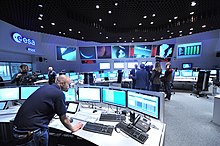
Back Europese Ruimtevaartorganisasie Afrikaans ESA AN وكالة الفضاء الأوروبية Arabic إيزا ARY Axencia Espacial Europea AST Avropa Kosmik Agentliyi Azerbaijani ESA BCL Еўрапейскае касмічнае агенцтва Byelorussian Эўрапейская касьмічная агенцыя BE-X-OLD Европейска космическа агенция Bulgarian
| |
 | |
 Logo | |
 Main control room of the European Space Operations Centre in Darmstadt, Germany | |
| Agency overview | |
|---|---|
| Abbreviation |
|
| Formed | 30 May 1975 |
| Type | Space agency |
| Headquarters | Paris, France 48°50′54″N 02°18′15″E / 48.84833°N 2.30417°E |
| Official language | English, French and German (working languages)[1][2] |
| Administrator | Josef Aschbacher (Director General of the European Space Agency) |
| Primary spaceport | Guiana Space Centre |
| Owners | Member states:
Council members: Associate members: Cooperation agreements:[3] |
| Employees | 2,547 (2023)[4] |
| Annual budget | |
| Website | esa |
The European Space Agency (ESA)[a] is a 23-member intergovernmental body devoted to space exploration.[8] With its headquarters in Paris and a staff of around 2,547 people globally as of 2023, the ESA was founded in 1975. Its 2024 annual budget was €7.79 billion.[5]
The ESA's space flight programme includes human spaceflight (mainly through participation in the International Space Station program); the launch and operation of crewless exploration missions to other planets (such as Mars) and the Moon; Earth observation, science and telecommunication; designing launch vehicles; and maintaining a major spaceport, the Guiana Space Centre at Kourou (French Guiana), France. The main European launch vehicle Ariane 6 will be operated through Arianespace with the ESA sharing in the costs of launching and further developing this launch vehicle. The agency is also working with NASA to manufacture the Orion spacecraft service module that flies on the Space Launch System.[9][10]
- ^ "Languages". Archived from the original on 18 November 2017. Retrieved 5 November 2017.
- ^ esa. "Frequently asked questions". Archived from the original on 27 August 2017. Retrieved 20 August 2017.
- ^ "ESA Member States and Cooperating States". European Space Agency. 1 January 2021. Retrieved 23 July 2024.
- ^ "ESA facts". European Space Agency. Archived from the original on 28 October 2021. Retrieved 13 February 2022.
- ^ a b "ESA budget 2024". www.esa.int.
- ^ "Annex 1 Resolution 8". ESA Convention and Council Rules of Procedure (PDF) (5th ed.). European Space Agency. March 2010. p. 116. ISBN 978-92-9092-965-9. Archived from the original on 6 June 2019. Retrieved 16 November 2014.
- ^ "Agence spatiale européenne (ASE)" [European Space Agency (ESA)]. 23 February 2017. Archived from the original on 10 October 2017. Retrieved 23 February 2017.
- ^ "Welcome to ESA: New Member States". ESA. Archived from the original on 8 November 2019. Retrieved 26 July 2017.
- ^ "Orion". European Space Agency. Archived from the original on 26 June 2018. Retrieved 26 June 2018.
- ^ "European Service Module". European Space Agency. Archived from the original on 26 June 2018. Retrieved 26 June 2018.
Cite error: There are <ref group=lower-alpha> tags or {{efn}} templates on this page, but the references will not show without a {{reflist|group=lower-alpha}} template or {{notelist}} template (see the help page).